Type 2 Diabetes and Ethnic Disparities
VerifiedAdded on 2020/01/15
|12
|3586
|156
AI Summary
This assignment analyzes the relationship between ethnicity and the prevalence of type 2 diabetes in the United Kingdom. It utilizes data from sources like Public Health England and the National Health Service to highlight disparities in diabetes rates across different ethnic groups. The text also explores factors contributing to these differences, including health beliefs and access to healthcare.
Contribute Materials
Your contribution can guide someone’s learning journey. Share your
documents today.
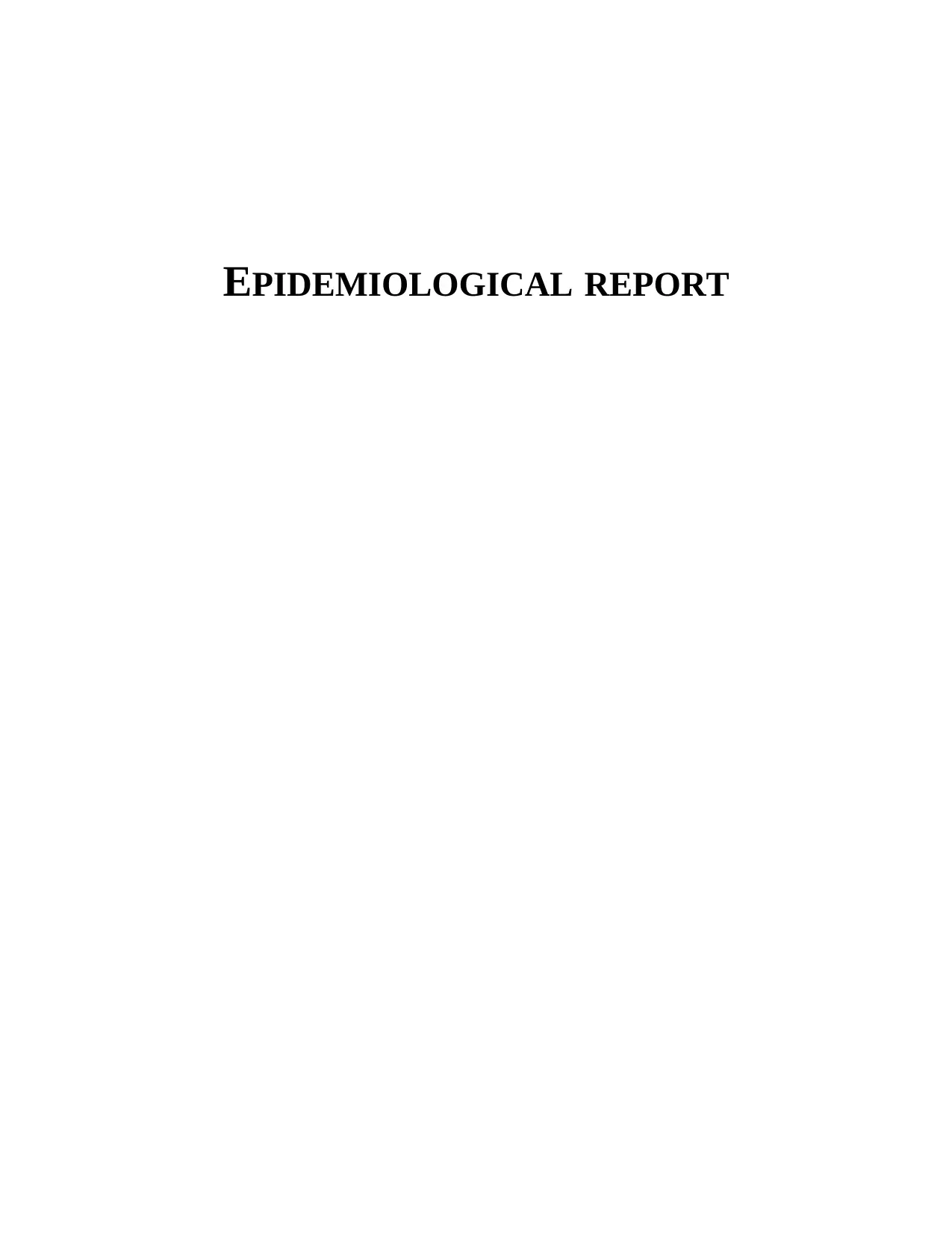
EPIDEMIOLOGICAL REPORT
Secure Best Marks with AI Grader
Need help grading? Try our AI Grader for instant feedback on your assignments.
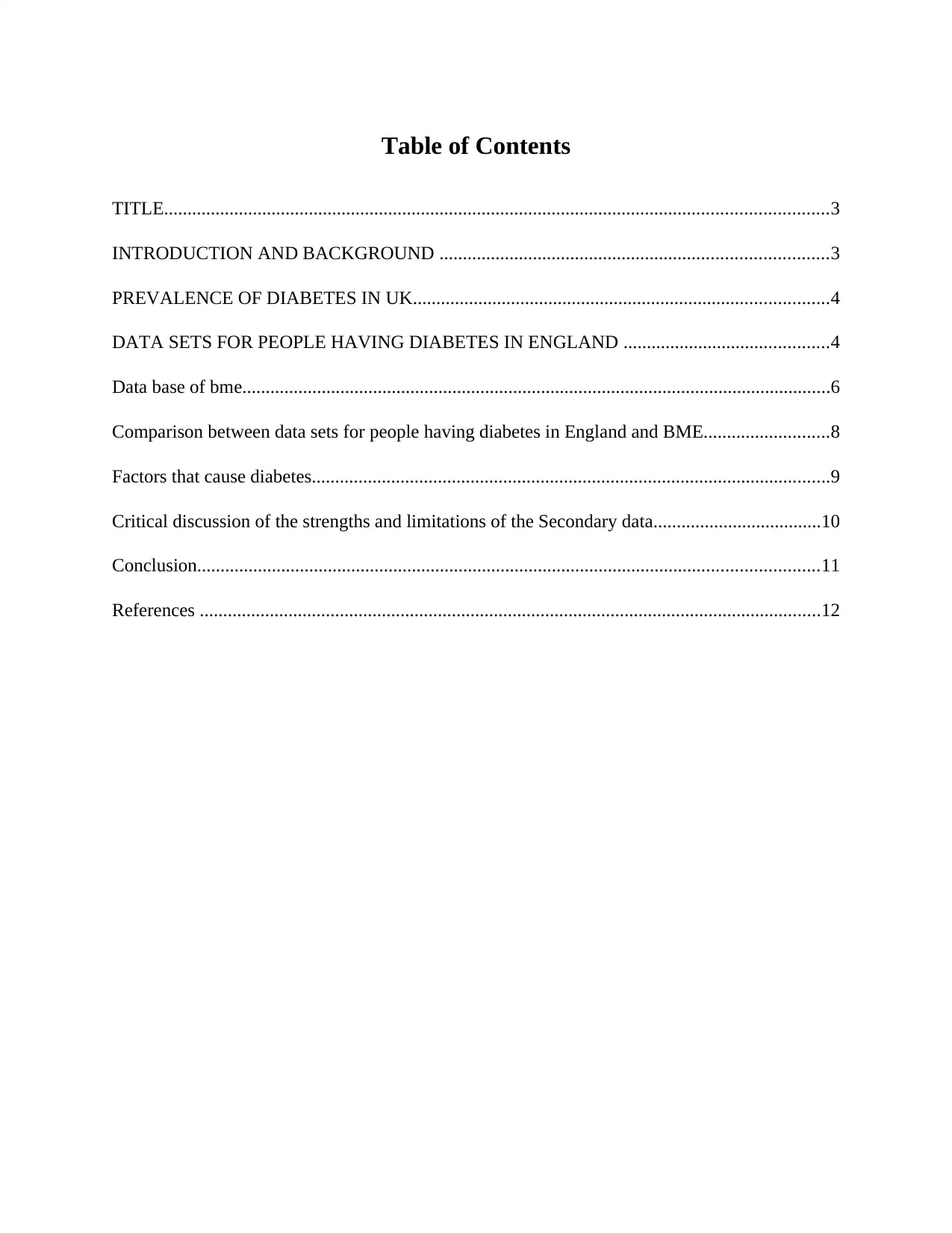
Table of Contents
TITLE..............................................................................................................................................3
INTRODUCTION AND BACKGROUND ...................................................................................3
PREVALENCE OF DIABETES IN UK.........................................................................................4
DATA SETS FOR PEOPLE HAVING DIABETES IN ENGLAND ............................................4
Data base of bme..............................................................................................................................6
Comparison between data sets for people having diabetes in England and BME...........................8
Factors that cause diabetes...............................................................................................................9
Critical discussion of the strengths and limitations of the Secondary data....................................10
Conclusion.....................................................................................................................................11
References .....................................................................................................................................12
TITLE..............................................................................................................................................3
INTRODUCTION AND BACKGROUND ...................................................................................3
PREVALENCE OF DIABETES IN UK.........................................................................................4
DATA SETS FOR PEOPLE HAVING DIABETES IN ENGLAND ............................................4
Data base of bme..............................................................................................................................6
Comparison between data sets for people having diabetes in England and BME...........................8
Factors that cause diabetes...............................................................................................................9
Critical discussion of the strengths and limitations of the Secondary data....................................10
Conclusion.....................................................................................................................................11
References .....................................................................................................................................12
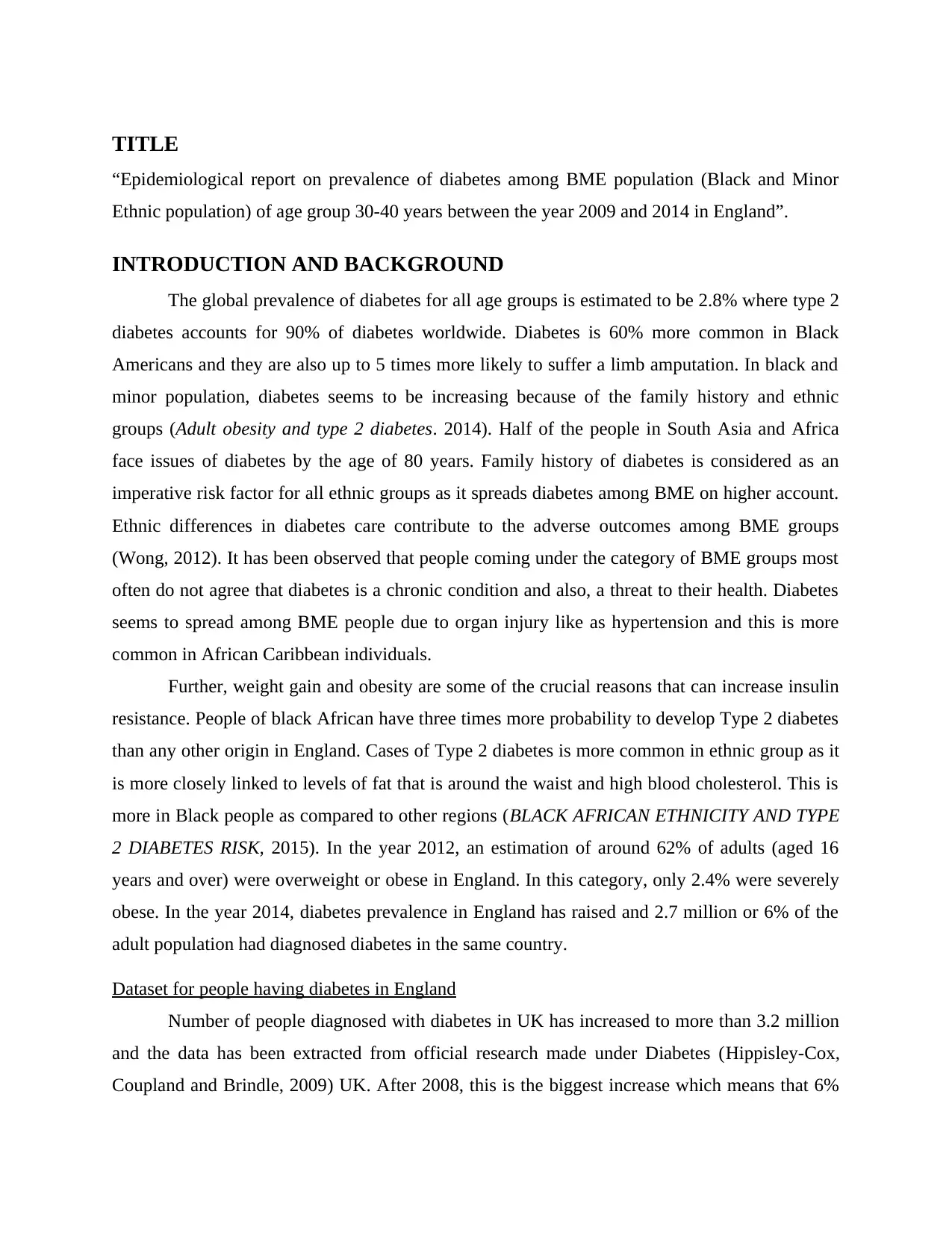
TITLE
“Epidemiological report on prevalence of diabetes among BME population (Black and Minor
Ethnic population) of age group 30-40 years between the year 2009 and 2014 in England”.
INTRODUCTION AND BACKGROUND
The global prevalence of diabetes for all age groups is estimated to be 2.8% where type 2
diabetes accounts for 90% of diabetes worldwide. Diabetes is 60% more common in Black
Americans and they are also up to 5 times more likely to suffer a limb amputation. In black and
minor population, diabetes seems to be increasing because of the family history and ethnic
groups (Adult obesity and type 2 diabetes. 2014). Half of the people in South Asia and Africa
face issues of diabetes by the age of 80 years. Family history of diabetes is considered as an
imperative risk factor for all ethnic groups as it spreads diabetes among BME on higher account.
Ethnic differences in diabetes care contribute to the adverse outcomes among BME groups
(Wong, 2012). It has been observed that people coming under the category of BME groups most
often do not agree that diabetes is a chronic condition and also, a threat to their health. Diabetes
seems to spread among BME people due to organ injury like as hypertension and this is more
common in African Caribbean individuals.
Further, weight gain and obesity are some of the crucial reasons that can increase insulin
resistance. People of black African have three times more probability to develop Type 2 diabetes
than any other origin in England. Cases of Type 2 diabetes is more common in ethnic group as it
is more closely linked to levels of fat that is around the waist and high blood cholesterol. This is
more in Black people as compared to other regions (BLACK AFRICAN ETHNICITY AND TYPE
2 DIABETES RISK, 2015). In the year 2012, an estimation of around 62% of adults (aged 16
years and over) were overweight or obese in England. In this category, only 2.4% were severely
obese. In the year 2014, diabetes prevalence in England has raised and 2.7 million or 6% of the
adult population had diagnosed diabetes in the same country.
Dataset for people having diabetes in England
Number of people diagnosed with diabetes in UK has increased to more than 3.2 million
and the data has been extracted from official research made under Diabetes (Hippisley-Cox,
Coupland and Brindle, 2009) UK. After 2008, this is the biggest increase which means that 6%
“Epidemiological report on prevalence of diabetes among BME population (Black and Minor
Ethnic population) of age group 30-40 years between the year 2009 and 2014 in England”.
INTRODUCTION AND BACKGROUND
The global prevalence of diabetes for all age groups is estimated to be 2.8% where type 2
diabetes accounts for 90% of diabetes worldwide. Diabetes is 60% more common in Black
Americans and they are also up to 5 times more likely to suffer a limb amputation. In black and
minor population, diabetes seems to be increasing because of the family history and ethnic
groups (Adult obesity and type 2 diabetes. 2014). Half of the people in South Asia and Africa
face issues of diabetes by the age of 80 years. Family history of diabetes is considered as an
imperative risk factor for all ethnic groups as it spreads diabetes among BME on higher account.
Ethnic differences in diabetes care contribute to the adverse outcomes among BME groups
(Wong, 2012). It has been observed that people coming under the category of BME groups most
often do not agree that diabetes is a chronic condition and also, a threat to their health. Diabetes
seems to spread among BME people due to organ injury like as hypertension and this is more
common in African Caribbean individuals.
Further, weight gain and obesity are some of the crucial reasons that can increase insulin
resistance. People of black African have three times more probability to develop Type 2 diabetes
than any other origin in England. Cases of Type 2 diabetes is more common in ethnic group as it
is more closely linked to levels of fat that is around the waist and high blood cholesterol. This is
more in Black people as compared to other regions (BLACK AFRICAN ETHNICITY AND TYPE
2 DIABETES RISK, 2015). In the year 2012, an estimation of around 62% of adults (aged 16
years and over) were overweight or obese in England. In this category, only 2.4% were severely
obese. In the year 2014, diabetes prevalence in England has raised and 2.7 million or 6% of the
adult population had diagnosed diabetes in the same country.
Dataset for people having diabetes in England
Number of people diagnosed with diabetes in UK has increased to more than 3.2 million
and the data has been extracted from official research made under Diabetes (Hippisley-Cox,
Coupland and Brindle, 2009) UK. After 2008, this is the biggest increase which means that 6%
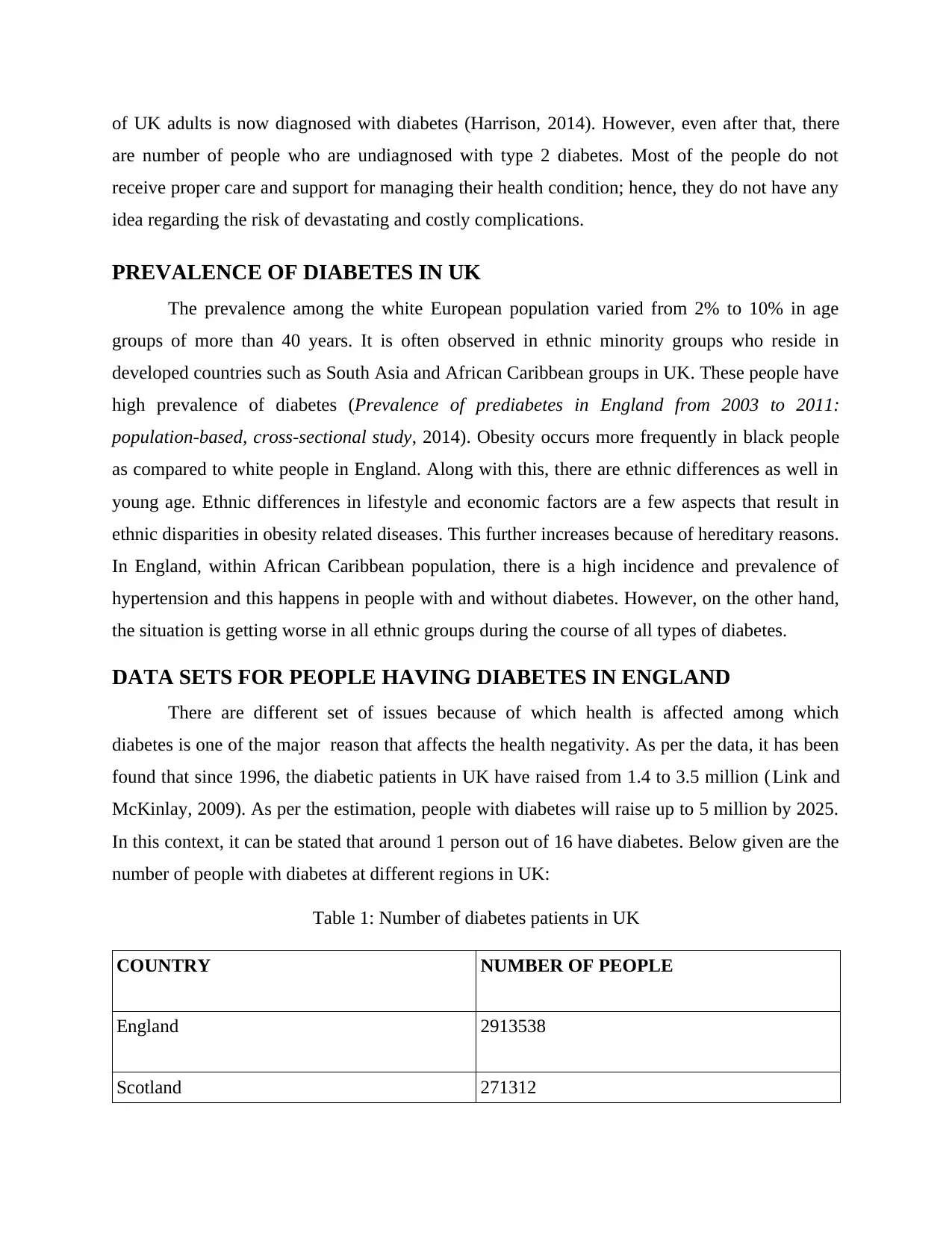
of UK adults is now diagnosed with diabetes (Harrison, 2014). However, even after that, there
are number of people who are undiagnosed with type 2 diabetes. Most of the people do not
receive proper care and support for managing their health condition; hence, they do not have any
idea regarding the risk of devastating and costly complications.
PREVALENCE OF DIABETES IN UK
The prevalence among the white European population varied from 2% to 10% in age
groups of more than 40 years. It is often observed in ethnic minority groups who reside in
developed countries such as South Asia and African Caribbean groups in UK. These people have
high prevalence of diabetes (Prevalence of prediabetes in England from 2003 to 2011:
population-based, cross-sectional study, 2014). Obesity occurs more frequently in black people
as compared to white people in England. Along with this, there are ethnic differences as well in
young age. Ethnic differences in lifestyle and economic factors are a few aspects that result in
ethnic disparities in obesity related diseases. This further increases because of hereditary reasons.
In England, within African Caribbean population, there is a high incidence and prevalence of
hypertension and this happens in people with and without diabetes. However, on the other hand,
the situation is getting worse in all ethnic groups during the course of all types of diabetes.
DATA SETS FOR PEOPLE HAVING DIABETES IN ENGLAND
There are different set of issues because of which health is affected among which
diabetes is one of the major reason that affects the health negativity. As per the data, it has been
found that since 1996, the diabetic patients in UK have raised from 1.4 to 3.5 million ( Link and
McKinlay, 2009). As per the estimation, people with diabetes will raise up to 5 million by 2025.
In this context, it can be stated that around 1 person out of 16 have diabetes. Below given are the
number of people with diabetes at different regions in UK:
Table 1: Number of diabetes patients in UK
COUNTRY NUMBER OF PEOPLE
England 2913538
Scotland 271312
are number of people who are undiagnosed with type 2 diabetes. Most of the people do not
receive proper care and support for managing their health condition; hence, they do not have any
idea regarding the risk of devastating and costly complications.
PREVALENCE OF DIABETES IN UK
The prevalence among the white European population varied from 2% to 10% in age
groups of more than 40 years. It is often observed in ethnic minority groups who reside in
developed countries such as South Asia and African Caribbean groups in UK. These people have
high prevalence of diabetes (Prevalence of prediabetes in England from 2003 to 2011:
population-based, cross-sectional study, 2014). Obesity occurs more frequently in black people
as compared to white people in England. Along with this, there are ethnic differences as well in
young age. Ethnic differences in lifestyle and economic factors are a few aspects that result in
ethnic disparities in obesity related diseases. This further increases because of hereditary reasons.
In England, within African Caribbean population, there is a high incidence and prevalence of
hypertension and this happens in people with and without diabetes. However, on the other hand,
the situation is getting worse in all ethnic groups during the course of all types of diabetes.
DATA SETS FOR PEOPLE HAVING DIABETES IN ENGLAND
There are different set of issues because of which health is affected among which
diabetes is one of the major reason that affects the health negativity. As per the data, it has been
found that since 1996, the diabetic patients in UK have raised from 1.4 to 3.5 million ( Link and
McKinlay, 2009). As per the estimation, people with diabetes will raise up to 5 million by 2025.
In this context, it can be stated that around 1 person out of 16 have diabetes. Below given are the
number of people with diabetes at different regions in UK:
Table 1: Number of diabetes patients in UK
COUNTRY NUMBER OF PEOPLE
England 2913538
Scotland 271312
Secure Best Marks with AI Grader
Need help grading? Try our AI Grader for instant feedback on your assignments.
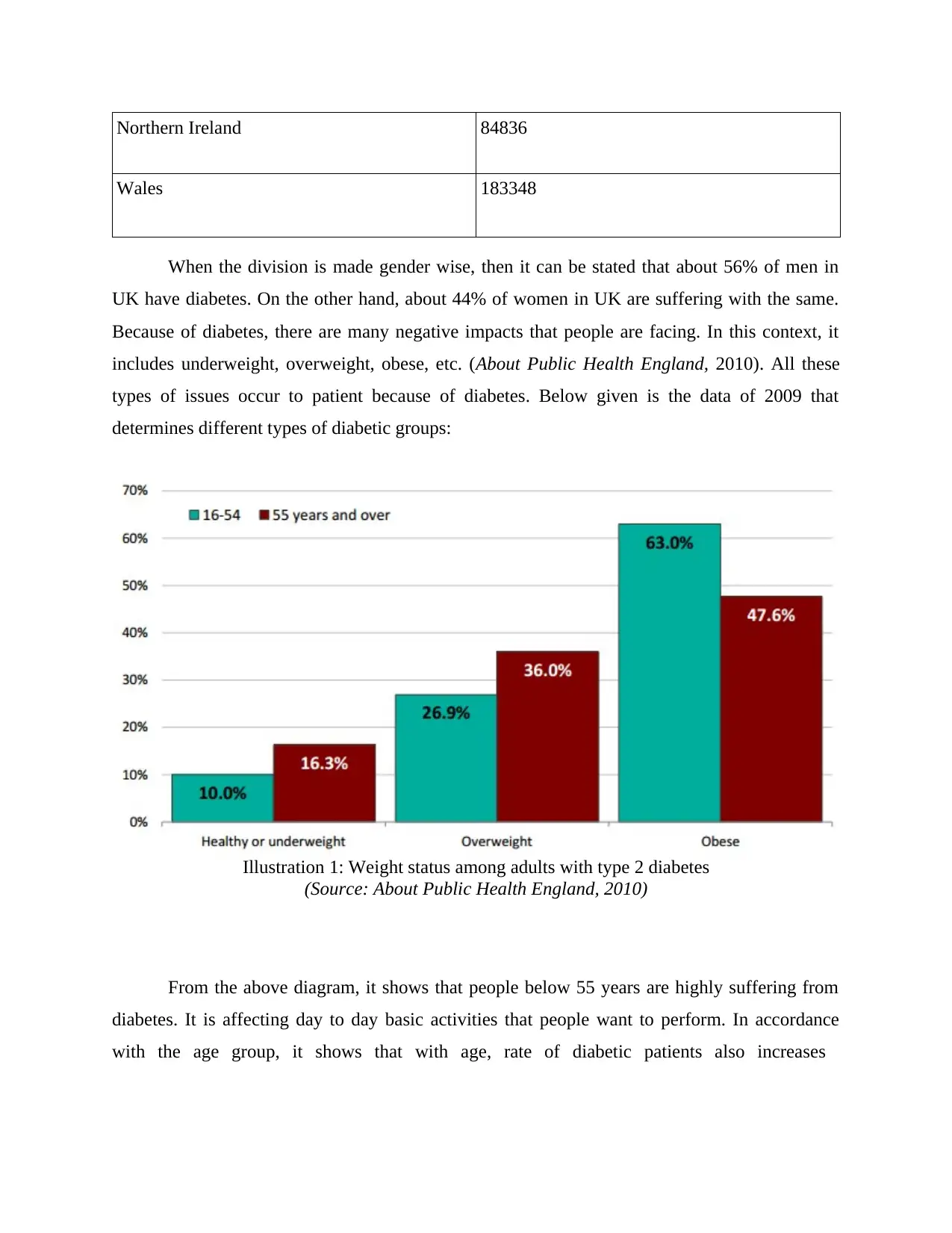
Northern Ireland 84836
Wales 183348
When the division is made gender wise, then it can be stated that about 56% of men in
UK have diabetes. On the other hand, about 44% of women in UK are suffering with the same.
Because of diabetes, there are many negative impacts that people are facing. In this context, it
includes underweight, overweight, obese, etc. (About Public Health England, 2010). All these
types of issues occur to patient because of diabetes. Below given is the data of 2009 that
determines different types of diabetic groups:
From the above diagram, it shows that people below 55 years are highly suffering from
diabetes. It is affecting day to day basic activities that people want to perform. In accordance
with the age group, it shows that with age, rate of diabetic patients also increases
Illustration 1: Weight status among adults with type 2 diabetes
(Source: About Public Health England, 2010)
Wales 183348
When the division is made gender wise, then it can be stated that about 56% of men in
UK have diabetes. On the other hand, about 44% of women in UK are suffering with the same.
Because of diabetes, there are many negative impacts that people are facing. In this context, it
includes underweight, overweight, obese, etc. (About Public Health England, 2010). All these
types of issues occur to patient because of diabetes. Below given is the data of 2009 that
determines different types of diabetic groups:
From the above diagram, it shows that people below 55 years are highly suffering from
diabetes. It is affecting day to day basic activities that people want to perform. In accordance
with the age group, it shows that with age, rate of diabetic patients also increases
Illustration 1: Weight status among adults with type 2 diabetes
(Source: About Public Health England, 2010)
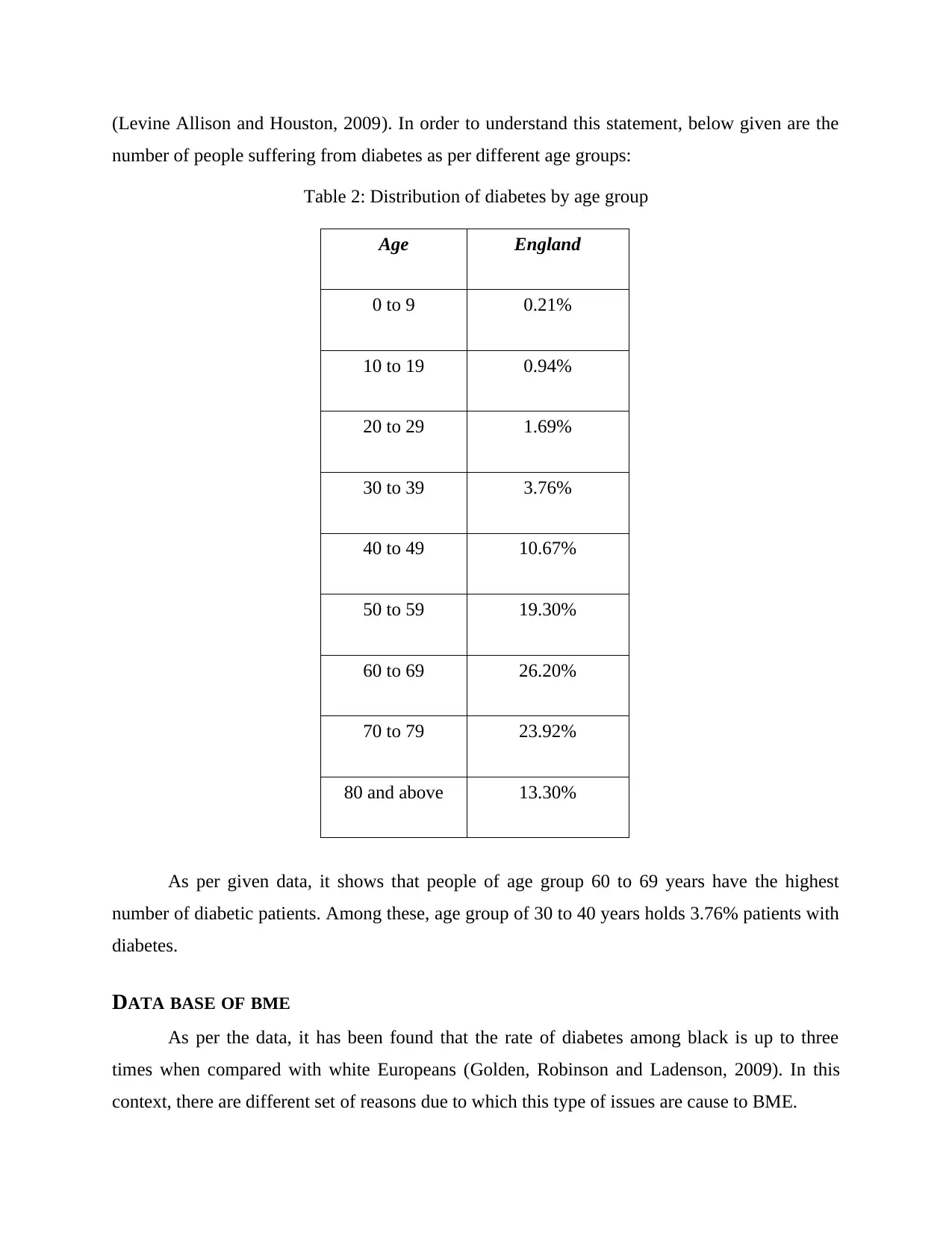
(Levine Allison and Houston, 2009). In order to understand this statement, below given are the
number of people suffering from diabetes as per different age groups:
Table 2: Distribution of diabetes by age group
Age England
0 to 9 0.21%
10 to 19 0.94%
20 to 29 1.69%
30 to 39 3.76%
40 to 49 10.67%
50 to 59 19.30%
60 to 69 26.20%
70 to 79 23.92%
80 and above 13.30%
As per given data, it shows that people of age group 60 to 69 years have the highest
number of diabetic patients. Among these, age group of 30 to 40 years holds 3.76% patients with
diabetes.
DATA BASE OF BME
As per the data, it has been found that the rate of diabetes among black is up to three
times when compared with white Europeans (Golden, Robinson and Ladenson, 2009). In this
context, there are different set of reasons due to which this type of issues are cause to BME.
number of people suffering from diabetes as per different age groups:
Table 2: Distribution of diabetes by age group
Age England
0 to 9 0.21%
10 to 19 0.94%
20 to 29 1.69%
30 to 39 3.76%
40 to 49 10.67%
50 to 59 19.30%
60 to 69 26.20%
70 to 79 23.92%
80 and above 13.30%
As per given data, it shows that people of age group 60 to 69 years have the highest
number of diabetic patients. Among these, age group of 30 to 40 years holds 3.76% patients with
diabetes.
DATA BASE OF BME
As per the data, it has been found that the rate of diabetes among black is up to three
times when compared with white Europeans (Golden, Robinson and Ladenson, 2009). In this
context, there are different set of reasons due to which this type of issues are cause to BME.
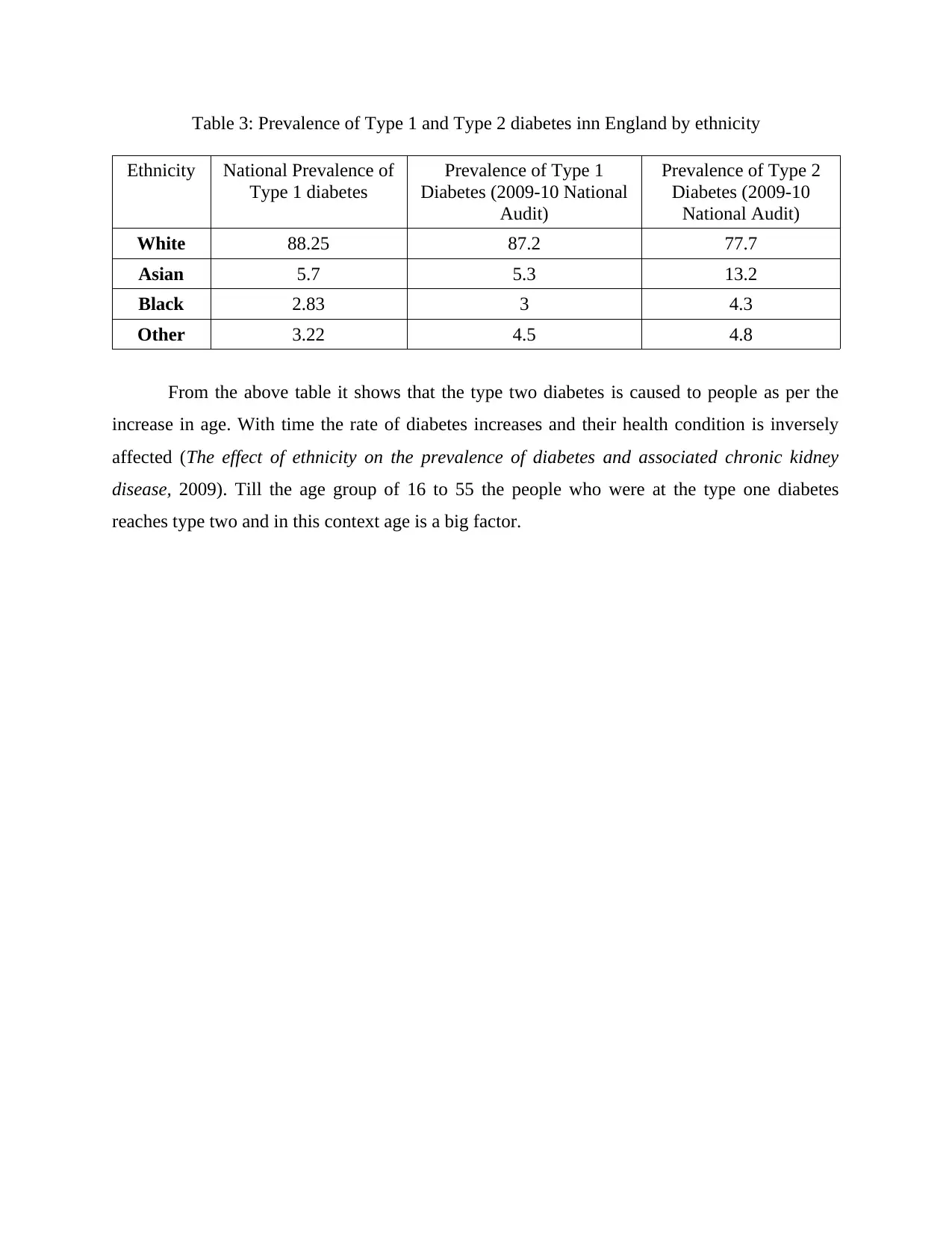
Table 3: Prevalence of Type 1 and Type 2 diabetes inn England by ethnicity
Ethnicity National Prevalence of
Type 1 diabetes
Prevalence of Type 1
Diabetes (2009-10 National
Audit)
Prevalence of Type 2
Diabetes (2009-10
National Audit)
White 88.25 87.2 77.7
Asian 5.7 5.3 13.2
Black 2.83 3 4.3
Other 3.22 4.5 4.8
From the above table it shows that the type two diabetes is caused to people as per the
increase in age. With time the rate of diabetes increases and their health condition is inversely
affected (The effect of ethnicity on the prevalence of diabetes and associated chronic kidney
disease, 2009). Till the age group of 16 to 55 the people who were at the type one diabetes
reaches type two and in this context age is a big factor.
Ethnicity National Prevalence of
Type 1 diabetes
Prevalence of Type 1
Diabetes (2009-10 National
Audit)
Prevalence of Type 2
Diabetes (2009-10
National Audit)
White 88.25 87.2 77.7
Asian 5.7 5.3 13.2
Black 2.83 3 4.3
Other 3.22 4.5 4.8
From the above table it shows that the type two diabetes is caused to people as per the
increase in age. With time the rate of diabetes increases and their health condition is inversely
affected (The effect of ethnicity on the prevalence of diabetes and associated chronic kidney
disease, 2009). Till the age group of 16 to 55 the people who were at the type one diabetes
reaches type two and in this context age is a big factor.
Paraphrase This Document
Need a fresh take? Get an instant paraphrase of this document with our AI Paraphraser
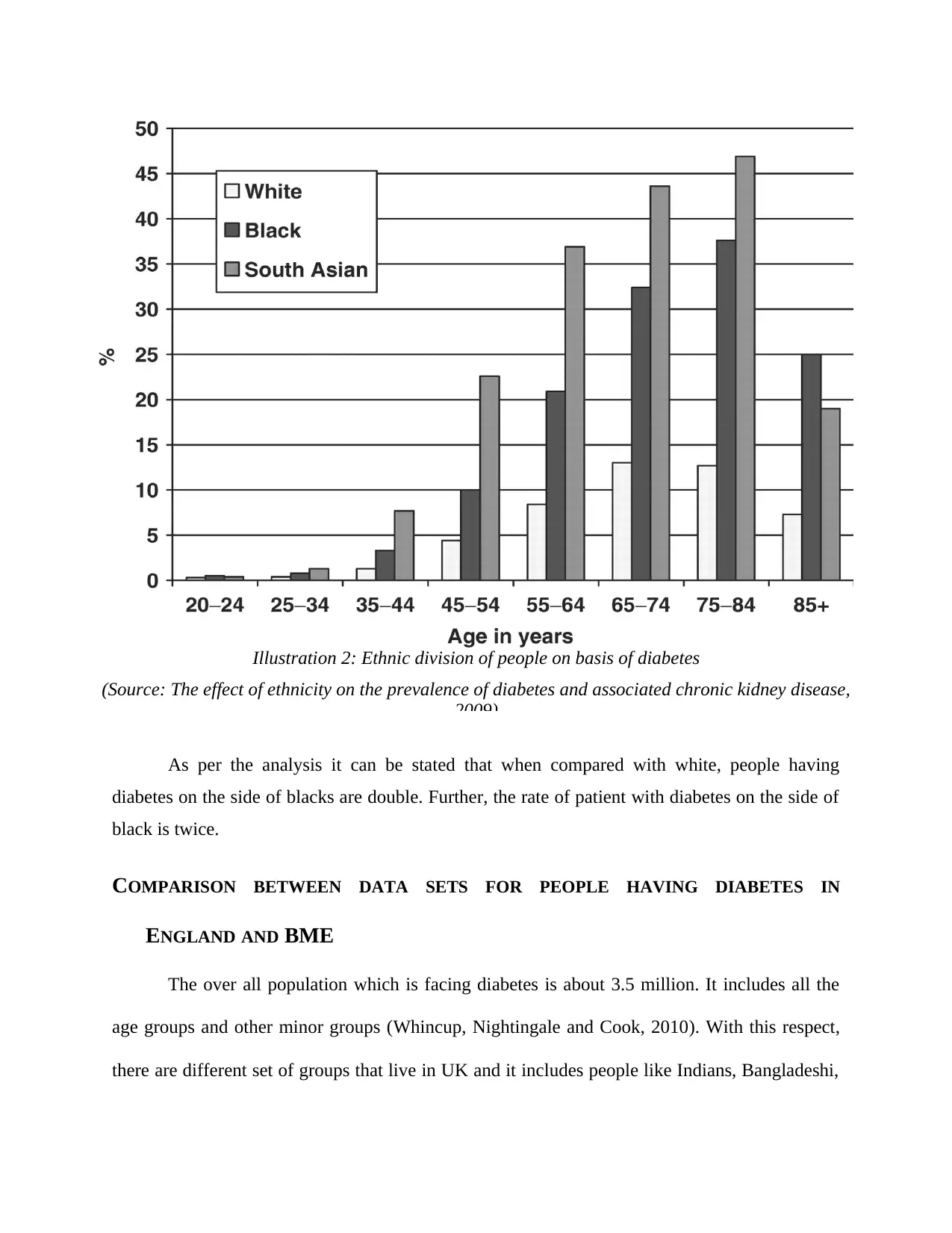
As per the analysis it can be stated that when compared with white, people having
diabetes on the side of blacks are double. Further, the rate of patient with diabetes on the side of
black is twice.
COMPARISON BETWEEN DATA SETS FOR PEOPLE HAVING DIABETES IN
ENGLAND AND BME
The over all population which is facing diabetes is about 3.5 million. It includes all the
age groups and other minor groups (Whincup, Nightingale and Cook, 2010). With this respect,
there are different set of groups that live in UK and it includes people like Indians, Bangladeshi,
Illustration 2: Ethnic division of people on basis of diabetes
(Source: The effect of ethnicity on the prevalence of diabetes and associated chronic kidney disease,
2009)
diabetes on the side of blacks are double. Further, the rate of patient with diabetes on the side of
black is twice.
COMPARISON BETWEEN DATA SETS FOR PEOPLE HAVING DIABETES IN
ENGLAND AND BME
The over all population which is facing diabetes is about 3.5 million. It includes all the
age groups and other minor groups (Whincup, Nightingale and Cook, 2010). With this respect,
there are different set of groups that live in UK and it includes people like Indians, Bangladeshi,
Illustration 2: Ethnic division of people on basis of diabetes
(Source: The effect of ethnicity on the prevalence of diabetes and associated chronic kidney disease,
2009)
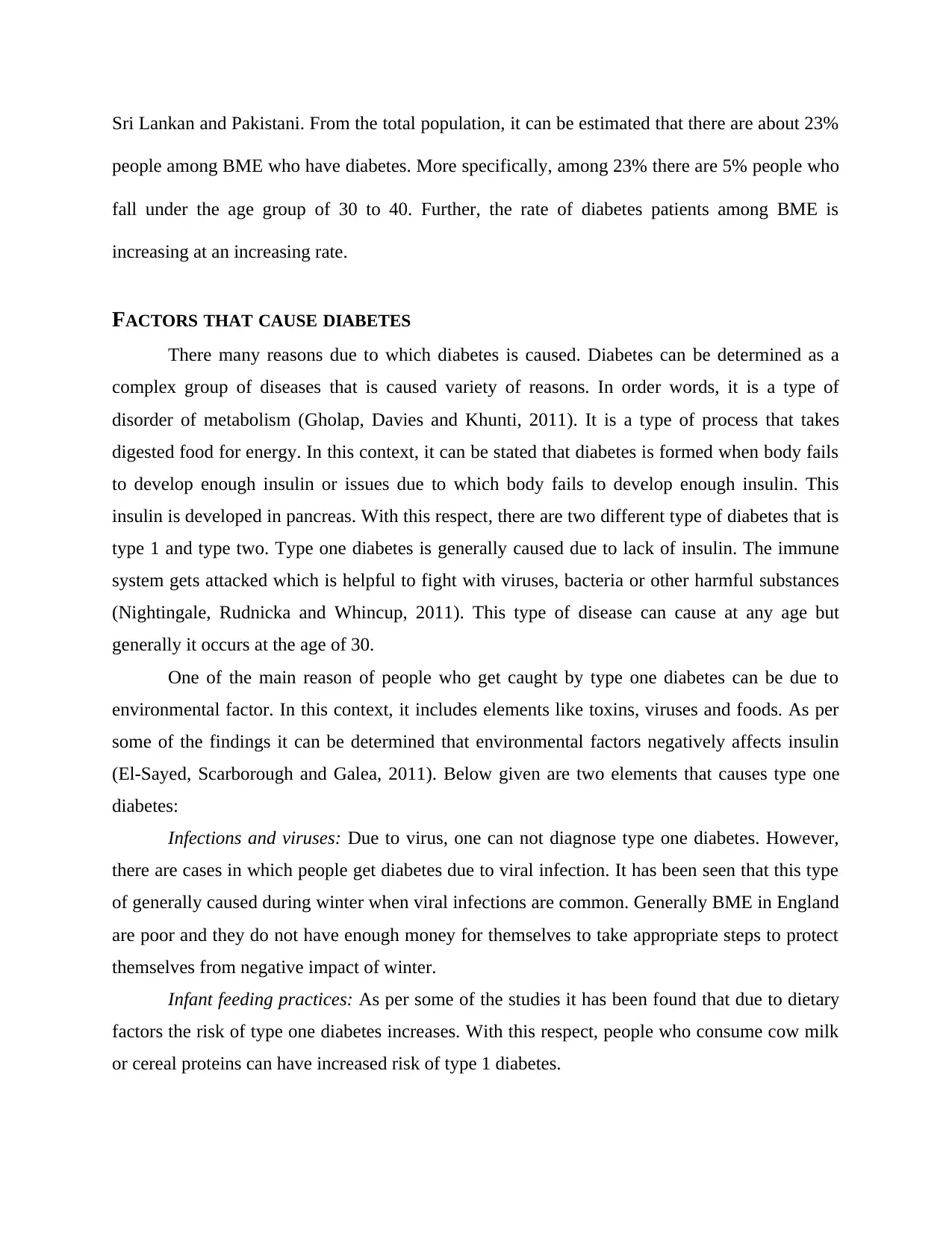
Sri Lankan and Pakistani. From the total population, it can be estimated that there are about 23%
people among BME who have diabetes. More specifically, among 23% there are 5% people who
fall under the age group of 30 to 40. Further, the rate of diabetes patients among BME is
increasing at an increasing rate.
FACTORS THAT CAUSE DIABETES
There many reasons due to which diabetes is caused. Diabetes can be determined as a
complex group of diseases that is caused variety of reasons. In order words, it is a type of
disorder of metabolism (Gholap, Davies and Khunti, 2011). It is a type of process that takes
digested food for energy. In this context, it can be stated that diabetes is formed when body fails
to develop enough insulin or issues due to which body fails to develop enough insulin. This
insulin is developed in pancreas. With this respect, there are two different type of diabetes that is
type 1 and type two. Type one diabetes is generally caused due to lack of insulin. The immune
system gets attacked which is helpful to fight with viruses, bacteria or other harmful substances
(Nightingale, Rudnicka and Whincup, 2011). This type of disease can cause at any age but
generally it occurs at the age of 30.
One of the main reason of people who get caught by type one diabetes can be due to
environmental factor. In this context, it includes elements like toxins, viruses and foods. As per
some of the findings it can be determined that environmental factors negatively affects insulin
(El‐Sayed, Scarborough and Galea, 2011). Below given are two elements that causes type one
diabetes:
Infections and viruses: Due to virus, one can not diagnose type one diabetes. However,
there are cases in which people get diabetes due to viral infection. It has been seen that this type
of generally caused during winter when viral infections are common. Generally BME in England
are poor and they do not have enough money for themselves to take appropriate steps to protect
themselves from negative impact of winter.
Infant feeding practices: As per some of the studies it has been found that due to dietary
factors the risk of type one diabetes increases. With this respect, people who consume cow milk
or cereal proteins can have increased risk of type 1 diabetes.
people among BME who have diabetes. More specifically, among 23% there are 5% people who
fall under the age group of 30 to 40. Further, the rate of diabetes patients among BME is
increasing at an increasing rate.
FACTORS THAT CAUSE DIABETES
There many reasons due to which diabetes is caused. Diabetes can be determined as a
complex group of diseases that is caused variety of reasons. In order words, it is a type of
disorder of metabolism (Gholap, Davies and Khunti, 2011). It is a type of process that takes
digested food for energy. In this context, it can be stated that diabetes is formed when body fails
to develop enough insulin or issues due to which body fails to develop enough insulin. This
insulin is developed in pancreas. With this respect, there are two different type of diabetes that is
type 1 and type two. Type one diabetes is generally caused due to lack of insulin. The immune
system gets attacked which is helpful to fight with viruses, bacteria or other harmful substances
(Nightingale, Rudnicka and Whincup, 2011). This type of disease can cause at any age but
generally it occurs at the age of 30.
One of the main reason of people who get caught by type one diabetes can be due to
environmental factor. In this context, it includes elements like toxins, viruses and foods. As per
some of the findings it can be determined that environmental factors negatively affects insulin
(El‐Sayed, Scarborough and Galea, 2011). Below given are two elements that causes type one
diabetes:
Infections and viruses: Due to virus, one can not diagnose type one diabetes. However,
there are cases in which people get diabetes due to viral infection. It has been seen that this type
of generally caused during winter when viral infections are common. Generally BME in England
are poor and they do not have enough money for themselves to take appropriate steps to protect
themselves from negative impact of winter.
Infant feeding practices: As per some of the studies it has been found that due to dietary
factors the risk of type one diabetes increases. With this respect, people who consume cow milk
or cereal proteins can have increased risk of type 1 diabetes.
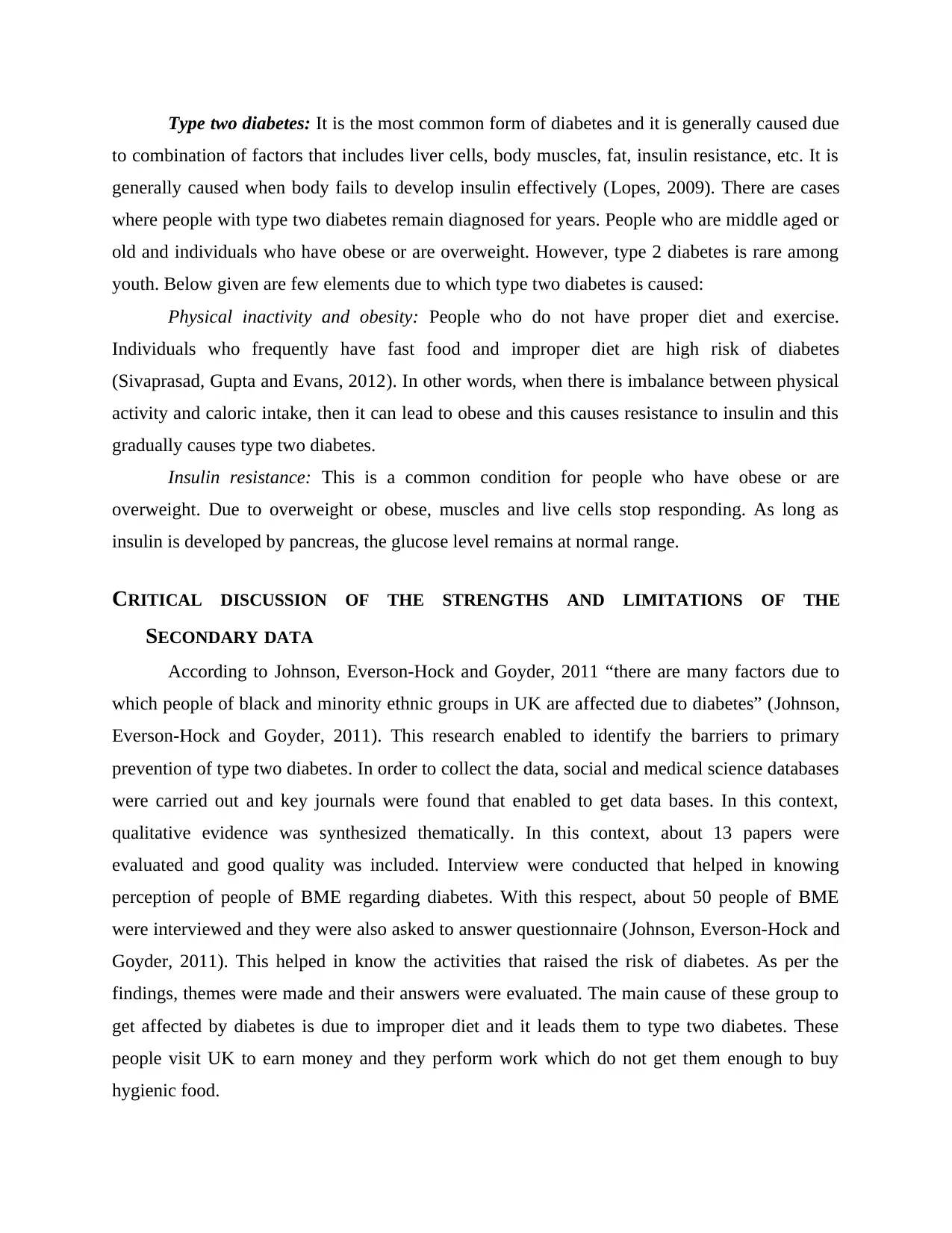
Type two diabetes: It is the most common form of diabetes and it is generally caused due
to combination of factors that includes liver cells, body muscles, fat, insulin resistance, etc. It is
generally caused when body fails to develop insulin effectively (Lopes, 2009). There are cases
where people with type two diabetes remain diagnosed for years. People who are middle aged or
old and individuals who have obese or are overweight. However, type 2 diabetes is rare among
youth. Below given are few elements due to which type two diabetes is caused:
Physical inactivity and obesity: People who do not have proper diet and exercise.
Individuals who frequently have fast food and improper diet are high risk of diabetes
(Sivaprasad, Gupta and Evans, 2012). In other words, when there is imbalance between physical
activity and caloric intake, then it can lead to obese and this causes resistance to insulin and this
gradually causes type two diabetes.
Insulin resistance: This is a common condition for people who have obese or are
overweight. Due to overweight or obese, muscles and live cells stop responding. As long as
insulin is developed by pancreas, the glucose level remains at normal range.
CRITICAL DISCUSSION OF THE STRENGTHS AND LIMITATIONS OF THE
SECONDARY DATA
According to Johnson, Everson-Hock and Goyder, 2011 “there are many factors due to
which people of black and minority ethnic groups in UK are affected due to diabetes” (Johnson,
Everson-Hock and Goyder, 2011). This research enabled to identify the barriers to primary
prevention of type two diabetes. In order to collect the data, social and medical science databases
were carried out and key journals were found that enabled to get data bases. In this context,
qualitative evidence was synthesized thematically. In this context, about 13 papers were
evaluated and good quality was included. Interview were conducted that helped in knowing
perception of people of BME regarding diabetes. With this respect, about 50 people of BME
were interviewed and they were also asked to answer questionnaire (Johnson, Everson-Hock and
Goyder, 2011). This helped in know the activities that raised the risk of diabetes. As per the
findings, themes were made and their answers were evaluated. The main cause of these group to
get affected by diabetes is due to improper diet and it leads them to type two diabetes. These
people visit UK to earn money and they perform work which do not get them enough to buy
hygienic food.
to combination of factors that includes liver cells, body muscles, fat, insulin resistance, etc. It is
generally caused when body fails to develop insulin effectively (Lopes, 2009). There are cases
where people with type two diabetes remain diagnosed for years. People who are middle aged or
old and individuals who have obese or are overweight. However, type 2 diabetes is rare among
youth. Below given are few elements due to which type two diabetes is caused:
Physical inactivity and obesity: People who do not have proper diet and exercise.
Individuals who frequently have fast food and improper diet are high risk of diabetes
(Sivaprasad, Gupta and Evans, 2012). In other words, when there is imbalance between physical
activity and caloric intake, then it can lead to obese and this causes resistance to insulin and this
gradually causes type two diabetes.
Insulin resistance: This is a common condition for people who have obese or are
overweight. Due to overweight or obese, muscles and live cells stop responding. As long as
insulin is developed by pancreas, the glucose level remains at normal range.
CRITICAL DISCUSSION OF THE STRENGTHS AND LIMITATIONS OF THE
SECONDARY DATA
According to Johnson, Everson-Hock and Goyder, 2011 “there are many factors due to
which people of black and minority ethnic groups in UK are affected due to diabetes” (Johnson,
Everson-Hock and Goyder, 2011). This research enabled to identify the barriers to primary
prevention of type two diabetes. In order to collect the data, social and medical science databases
were carried out and key journals were found that enabled to get data bases. In this context,
qualitative evidence was synthesized thematically. In this context, about 13 papers were
evaluated and good quality was included. Interview were conducted that helped in knowing
perception of people of BME regarding diabetes. With this respect, about 50 people of BME
were interviewed and they were also asked to answer questionnaire (Johnson, Everson-Hock and
Goyder, 2011). This helped in know the activities that raised the risk of diabetes. As per the
findings, themes were made and their answers were evaluated. The main cause of these group to
get affected by diabetes is due to improper diet and it leads them to type two diabetes. These
people visit UK to earn money and they perform work which do not get them enough to buy
hygienic food.
Secure Best Marks with AI Grader
Need help grading? Try our AI Grader for instant feedback on your assignments.
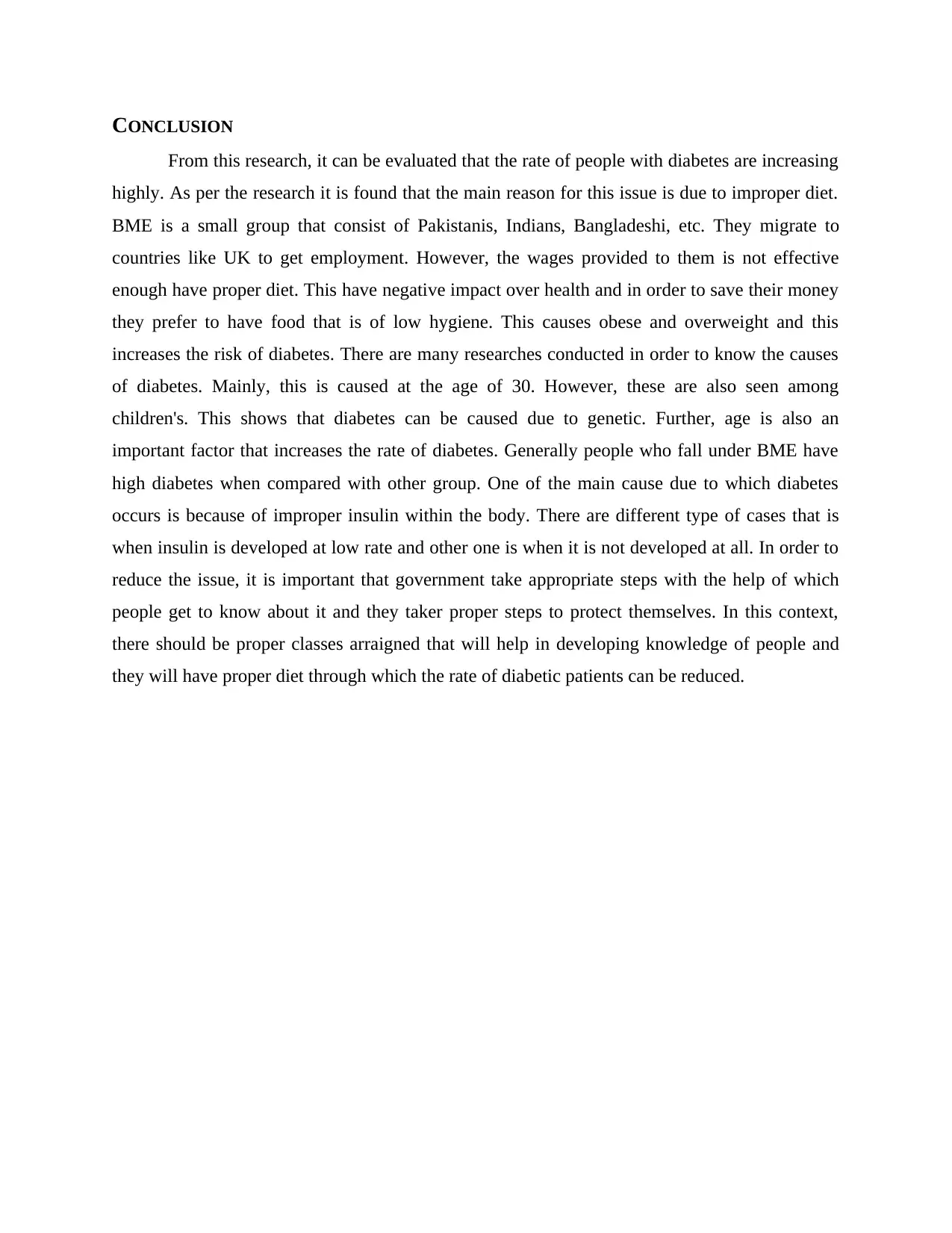
CONCLUSION
From this research, it can be evaluated that the rate of people with diabetes are increasing
highly. As per the research it is found that the main reason for this issue is due to improper diet.
BME is a small group that consist of Pakistanis, Indians, Bangladeshi, etc. They migrate to
countries like UK to get employment. However, the wages provided to them is not effective
enough have proper diet. This have negative impact over health and in order to save their money
they prefer to have food that is of low hygiene. This causes obese and overweight and this
increases the risk of diabetes. There are many researches conducted in order to know the causes
of diabetes. Mainly, this is caused at the age of 30. However, these are also seen among
children's. This shows that diabetes can be caused due to genetic. Further, age is also an
important factor that increases the rate of diabetes. Generally people who fall under BME have
high diabetes when compared with other group. One of the main cause due to which diabetes
occurs is because of improper insulin within the body. There are different type of cases that is
when insulin is developed at low rate and other one is when it is not developed at all. In order to
reduce the issue, it is important that government take appropriate steps with the help of which
people get to know about it and they taker proper steps to protect themselves. In this context,
there should be proper classes arraigned that will help in developing knowledge of people and
they will have proper diet through which the rate of diabetic patients can be reduced.
From this research, it can be evaluated that the rate of people with diabetes are increasing
highly. As per the research it is found that the main reason for this issue is due to improper diet.
BME is a small group that consist of Pakistanis, Indians, Bangladeshi, etc. They migrate to
countries like UK to get employment. However, the wages provided to them is not effective
enough have proper diet. This have negative impact over health and in order to save their money
they prefer to have food that is of low hygiene. This causes obese and overweight and this
increases the risk of diabetes. There are many researches conducted in order to know the causes
of diabetes. Mainly, this is caused at the age of 30. However, these are also seen among
children's. This shows that diabetes can be caused due to genetic. Further, age is also an
important factor that increases the rate of diabetes. Generally people who fall under BME have
high diabetes when compared with other group. One of the main cause due to which diabetes
occurs is because of improper insulin within the body. There are different type of cases that is
when insulin is developed at low rate and other one is when it is not developed at all. In order to
reduce the issue, it is important that government take appropriate steps with the help of which
people get to know about it and they taker proper steps to protect themselves. In this context,
there should be proper classes arraigned that will help in developing knowledge of people and
they will have proper diet through which the rate of diabetic patients can be reduced.
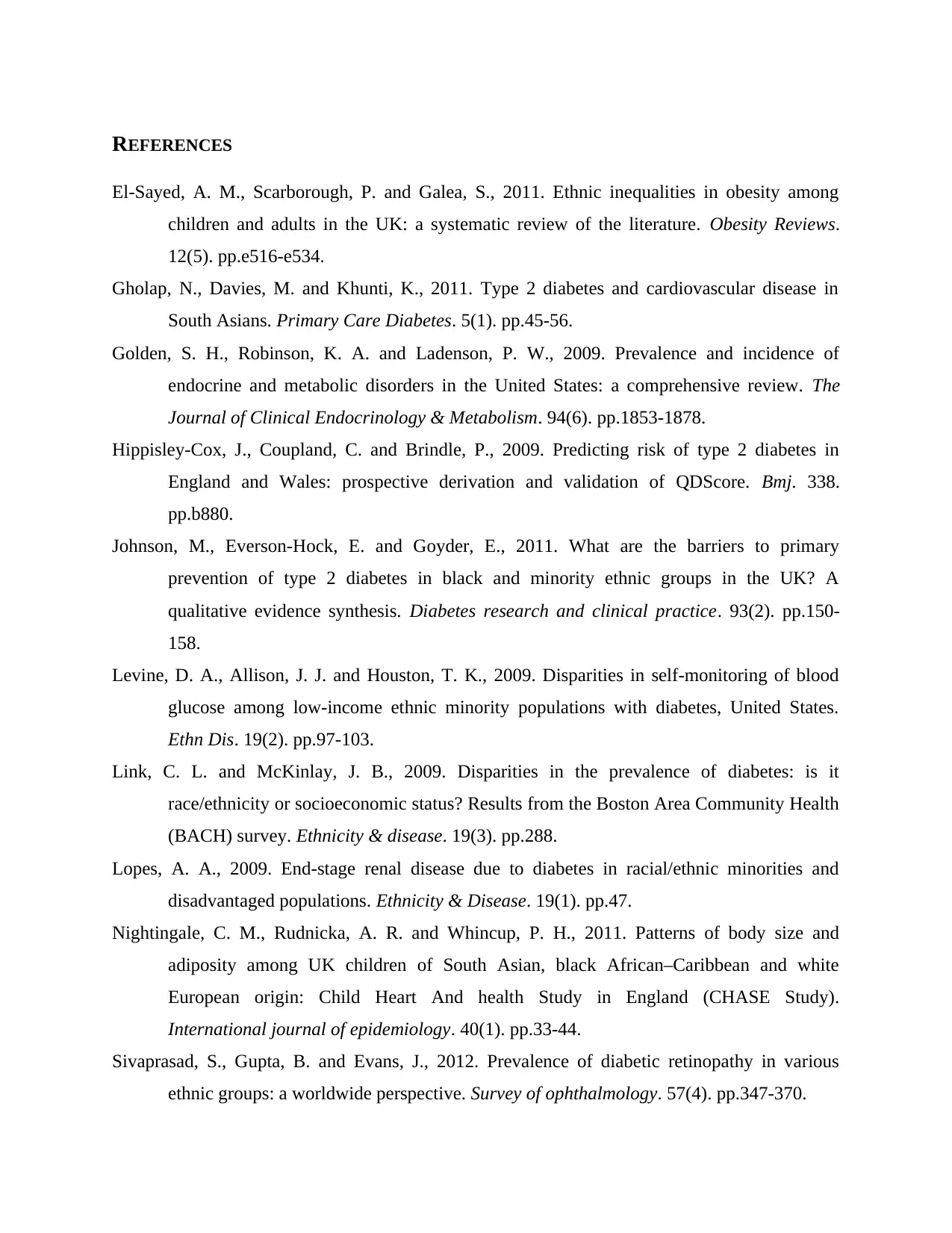
REFERENCES
El‐Sayed, A. M., Scarborough, P. and Galea, S., 2011. Ethnic inequalities in obesity among
children and adults in the UK: a systematic review of the literature. Obesity Reviews.
12(5). pp.e516-e534.
Gholap, N., Davies, M. and Khunti, K., 2011. Type 2 diabetes and cardiovascular disease in
South Asians. Primary Care Diabetes. 5(1). pp.45-56.
Golden, S. H., Robinson, K. A. and Ladenson, P. W., 2009. Prevalence and incidence of
endocrine and metabolic disorders in the United States: a comprehensive review. The
Journal of Clinical Endocrinology & Metabolism. 94(6). pp.1853-1878.
Hippisley-Cox, J., Coupland, C. and Brindle, P., 2009. Predicting risk of type 2 diabetes in
England and Wales: prospective derivation and validation of QDScore. Bmj. 338.
pp.b880.
Johnson, M., Everson-Hock, E. and Goyder, E., 2011. What are the barriers to primary
prevention of type 2 diabetes in black and minority ethnic groups in the UK? A
qualitative evidence synthesis. Diabetes research and clinical practice. 93(2). pp.150-
158.
Levine, D. A., Allison, J. J. and Houston, T. K., 2009. Disparities in self-monitoring of blood
glucose among low-income ethnic minority populations with diabetes, United States.
Ethn Dis. 19(2). pp.97-103.
Link, C. L. and McKinlay, J. B., 2009. Disparities in the prevalence of diabetes: is it
race/ethnicity or socioeconomic status? Results from the Boston Area Community Health
(BACH) survey. Ethnicity & disease. 19(3). pp.288.
Lopes, A. A., 2009. End-stage renal disease due to diabetes in racial/ethnic minorities and
disadvantaged populations. Ethnicity & Disease. 19(1). pp.47.
Nightingale, C. M., Rudnicka, A. R. and Whincup, P. H., 2011. Patterns of body size and
adiposity among UK children of South Asian, black African–Caribbean and white
European origin: Child Heart And health Study in England (CHASE Study).
International journal of epidemiology. 40(1). pp.33-44.
Sivaprasad, S., Gupta, B. and Evans, J., 2012. Prevalence of diabetic retinopathy in various
ethnic groups: a worldwide perspective. Survey of ophthalmology. 57(4). pp.347-370.
El‐Sayed, A. M., Scarborough, P. and Galea, S., 2011. Ethnic inequalities in obesity among
children and adults in the UK: a systematic review of the literature. Obesity Reviews.
12(5). pp.e516-e534.
Gholap, N., Davies, M. and Khunti, K., 2011. Type 2 diabetes and cardiovascular disease in
South Asians. Primary Care Diabetes. 5(1). pp.45-56.
Golden, S. H., Robinson, K. A. and Ladenson, P. W., 2009. Prevalence and incidence of
endocrine and metabolic disorders in the United States: a comprehensive review. The
Journal of Clinical Endocrinology & Metabolism. 94(6). pp.1853-1878.
Hippisley-Cox, J., Coupland, C. and Brindle, P., 2009. Predicting risk of type 2 diabetes in
England and Wales: prospective derivation and validation of QDScore. Bmj. 338.
pp.b880.
Johnson, M., Everson-Hock, E. and Goyder, E., 2011. What are the barriers to primary
prevention of type 2 diabetes in black and minority ethnic groups in the UK? A
qualitative evidence synthesis. Diabetes research and clinical practice. 93(2). pp.150-
158.
Levine, D. A., Allison, J. J. and Houston, T. K., 2009. Disparities in self-monitoring of blood
glucose among low-income ethnic minority populations with diabetes, United States.
Ethn Dis. 19(2). pp.97-103.
Link, C. L. and McKinlay, J. B., 2009. Disparities in the prevalence of diabetes: is it
race/ethnicity or socioeconomic status? Results from the Boston Area Community Health
(BACH) survey. Ethnicity & disease. 19(3). pp.288.
Lopes, A. A., 2009. End-stage renal disease due to diabetes in racial/ethnic minorities and
disadvantaged populations. Ethnicity & Disease. 19(1). pp.47.
Nightingale, C. M., Rudnicka, A. R. and Whincup, P. H., 2011. Patterns of body size and
adiposity among UK children of South Asian, black African–Caribbean and white
European origin: Child Heart And health Study in England (CHASE Study).
International journal of epidemiology. 40(1). pp.33-44.
Sivaprasad, S., Gupta, B. and Evans, J., 2012. Prevalence of diabetic retinopathy in various
ethnic groups: a worldwide perspective. Survey of ophthalmology. 57(4). pp.347-370.
1 out of 12
Related Documents
Your All-in-One AI-Powered Toolkit for Academic Success.
+13062052269
info@desklib.com
Available 24*7 on WhatsApp / Email
![[object Object]](/_next/static/media/star-bottom.7253800d.svg)
Unlock your academic potential
© 2024 | Zucol Services PVT LTD | All rights reserved.





